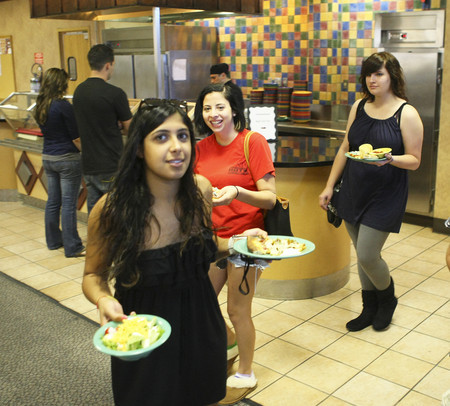Going trayless saves water
It has been said so often, "small things can make a big difference," that it has become a cliché. It is a corporate catchphrase, a marketing scheme, a feel-good blah blah blah that gets lost in the rest of the white noise.
And yet, clichés are sometimes true.
Proof: The cafeteria at the University of Nevada, Las Vegas, which is called the dining commons, eliminated the plastic trays students use to carry food from the buffet line to their tables. They are the same trays you use at the mall food court, or at McDonald's.
That simple move, made at the beginning of the 2008-09 academic year, saved 88,000 gallons of water last year because the trays don't have to be washed anymore.
It stopped 53,000 pounds of food from going into the compost heap, because when you don't have a tray, you don't grab as much food.
That's enough water, by the way, to supply an average household for about six months. Or to cover a football field in three inches of water. Or to fill an 88,000-gallon pool (that's huge).
Fifty-three thousand pounds of food would feed you, dear reader, for most of your life.
"Our food waste has really gone down because of being trayless," said Susan Fukushima, the resident district manager of dining services at UNLV, which are operated by Sodexo. "The students aren't loading up and trying two bites of something and then throwing it away."
The cafeteria serves mostly students who live on campus, with some faculty and staff thrown in. It serves about 1,600 meals a day. It operates as a buffet, with diners choosing from several bars of food: pizza, burgers, subs, salads, etc.
Sodexo operates food services on about 900 campuses around the country. Fukushima said more than half of them have gone trayless.
The process hasn't been all rainbows and unicorns. Students are now forced to juggle a salad plate, an entree or two, soup, a dessert and a drink all at once.
Or they go back for seconds. If they feel like it. If they're not already full.
Which brings us to another Small Things-Big Difference example.
"It's tremendous the impact it has had," said Debi Meyer, a registered dietitian with UNLV's Wellness Center.
She said a typical freshman will gain four to seven pounds in the first few months of college. (It's not the fabled "freshman 15," but it's something.)
But since the cafeteria went trayless, many students are opting to eat less, Meyer said.
There could be a couple of reasons. First, maybe it's laziness. Maybe they just don't feel like getting up for seconds.
Or, more likely, it's because it takes about 20 minutes for our bodies to realize they're full, Meyer said.
So, if you've got a tray full of pizza, stir-fry, salad, a sub and a burger, you're going to eat it all -- or too much of it -- before your brain gets the message. Then you'll toss the rest onto the compost pile.
There isn't any hard evidence that the trayless trend is making students slimmer -- nobody's asking them to weigh in before lunch -- but Meyer said it makes sense that it is doing so.
Noted Beth Bayrd, UNLV dining marketing manager, "Our eyes are always bigger than our stomachs."
But our plates are not.
Contact reporter Richard Lake at rlake @reviewjournal.com or 702-383-0307.

















